Margot Note's Blog, page 46
December 4, 2017
Merry & Bright: Five Tips for Preserving Family Heirlooms
I have to admit it—I'm a Grinch.
I've always been this way. I think of the holidays as a time to get through, though I appreciate a celebration of warmth, light, and love in the middle of the winter.
The holiday season can be tough for some of us. It's a time of reflection for all the experiences of the past year, good and bad. The season makes us think of family memories, which can be a source of happiness and sadness.
When I organize archives for clients, I'm struck by how little of today's messages are physical. For example, in a folder of my late father's correspondence to me, I only have two short printed-out emails. Nothing handwritten, nothing not born-digital. I treasure those special emails, but how I wish that they were written in his script!
In the spirit of keeping it real, I'm sending readers a handy cheat sheet, Five Tips to Preserving Family Heirlooms, to shine a little light during a time that can be emotional for us all. "Real" is the key word, because as much as our lives are digital, the tangible world—the real—excites us and connects us as humans. The cheat sheet is limited to the first 50 people that reply.
If you are interested in receiving the cheat sheet, please fill out the form below. (This information will be used for no other purpose and will not be shared, sold, or any other action that would put me on Santa's naughty list).
Name *
Name
First Name
Last Name
Address
Address
Address 1
Address 2
City
State/Province
Zip/Postal Code
Country
May your Season Be Merry and Bright!
If you like archives, memory, and legacy as much as I do, you might consider signing up for my email list. Every few weeks I send out a newsletter with new articles and exclusive content for readers. It’s basically my way of keeping in touch with you and letting you know what’s going on. Your information is protected and I never spam.
To learn the preservation secrets used by libraries, archives, and museums to protect their priceless materials (that you can also use for your family heritage items), read my book:
Creating Family Archives: How to Preserve Your Papers and Photographs
By Margot Note
Ready to get started creating your family archives? Here are some of my favorite products
Follow me on Pinterest | Instagram | Twitter | LinkedIn | Facebook

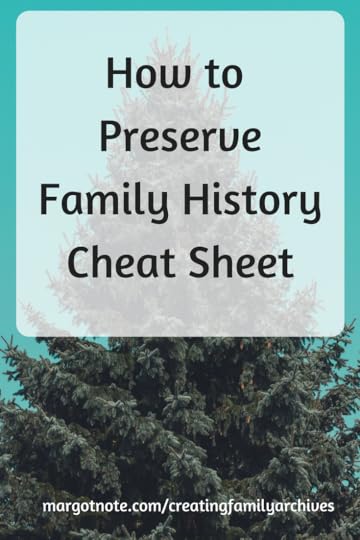

November 27, 2017
Highlighting Family & Personal History Businesses
This holiday season, I'm sharing some entrepreneurs and small businesses that offer services related to memory, legacy, and family and personal history. I wish to amplify their reach so that as many people as possible know about their offerings.
I've noted the location of the businesses, but like most things these days, the Internet gives them the power to serve clients around the United States and the world. For example, I offer Family Archives Packages, and many of my clients aren’t local. Depending on the project, companies and clients can connect as easily by email or by phone as in person.
Speaking from my own experiences, owning your own business is a labor of love. We work hard to provide unique, quality experiences and to delight our clients. By supporting smaller businesses in this field, you are helping others who share your values.
I've also asked my contributors to share their suggestions for capturing memories during the holiday season. What are yours?
Without further ado, I’ll let them speak for themselves:
The Beauty of BooksColrain, Massachusetts
As owner of The Beauty of Books, I provide book design (along with sometimes just cover design), production, and print supervision with printers ranging from Create Space (gets you on Amazon) and Ingram Spark (gets you into bookstores) — both Print-on-Demand (POD) — to short-run digital and hi-end offset.
I offer scanning (with a large format professional scanner) and/or full project management, if needed.
I also offer self-publishing guidance to those who are wanting to get their books out into the world. This includes working with Create Space and Ingram, as well as offering recommendations for distribution, publicity, and social media help.
I think the most important service I provide is that I lend my ear as a human being alongside 40 years of experience.
Tip for capturing memories: The way I capture memories best is through my eyes and my ears. I watch. I listen. I open myself to those around me, drawing out my grown nieces and nephews, my son and daughter, wanting to hear THEIR perspective on how the world—and their lives within it—are turning. I find that it is such a gift to learn from others. I always seem to grow, no matter what kind of experience I am around.
Cider Spoon StoriesAustin, Texas
Cider Spoon Stories is Austin's premier ghostwriting and editing company. We help seniors, veterans, small business owners, and others share their stories with the world. We have a book sale of 2 for $25 and free shipping when you use two discount codes: FREESHIP and HOLIDAY17.
Tip for capturing memories: Instead of staring at the TV screen after that double helping of turkey or ham, tune into each other. Oral storytelling was the original form of entertainment! Ask questions. Listen. Laugh. Love.
greetingStory (A product of Pass It Down)Chattanooga, Tennessee
greetingStory Memory Boxes are the perfect activity for your next family gathering whether it's Thanksgiving, Christmas, or a family reunion. Each Memory Box includes our famous storytelling cards and tips designed to spark conversations, collect incredible stories, and to preserve your family memories. greetingStory cards make it easy to capture our life stories by providing you with questions and instructions so all you have to do is share your memory inside the card.
Each Memory Box comes with illustrated question cards designed to help your family share memories and powerful stories. Each card includes tips & instructions, written by our team of biographers, to help guide your loved one in sharing their stories. greetingStory Boxes come in 12, 24, and 48 card sizes. When you order, we will email you our card catalog so you can customize the cards in your box (or let us choose for you)! Our cards have been proven to be simple and fun and you will love the priceless memories you collect.
Use the discount code BLACKFRIDAY35 for 35% off your entire order.
Tip for capturing memories: At greetingStory, our goal is to make capturing memories during the holiday season fun and stress-free. The number one tip we can give to make this process easy is to have a set of questions ready to ask your loved ones about different moments in their lives.
Isabelle Dervaux, Visual StorytellerBrooklyn, New York
After 30 years as an illustrator in publishing and advertising, I now help busy parents tell their family stories by empowering them to organize, rediscover, and curate their print and digital images. For the holidays, I’m adding one bonus hour of "Take better photos with your iPhone" if someone buys an Apple Photos: 8-Hour Coaching Package.
Tip for capturing memories: If you have a new phone, take the time to understand all of the new features. Be intentional while taking pictures. Make every photo count as if you were using a film camera. Take more pictures inside than outside. Mix family candids with posed photos. If you have to take pictures inside, place your subjects next to a window.
JournalscribeEast Glacier Park, Montana
JournalScribe helps individuals and families preserve, protect and share their handwritten history. Collections of paper records are not easy to share, and they can be lost forever to flood, fire, and time. I scan and transcribe these handwritten collections of letters, journals, diaries, logbooks, recipes, etc., and provide you with a beautiful keepsake book and the digital files, ensuring that your handwritten family treasures are preserved for generations to come.
I am offering a 20% discount on all projects initiated by 12/31/17.
Tip for capturing memories: This isn’t so much about capturing memories as it is about keeping memories. My tip is, “Back It Up!” Whether you’re recording photo or video memories on your smartphone or writing down your thoughts about a special event in your journal, to keep these memories for the long term, back them up. Back up your digital memories to the cloud or to your hard drive. You can connect your phone to your computer and easily download video, audio and photos to your computer. If the data becomes irretrievable or the phone is lost, you will still have those memories. For paper records, create a digital file by scanning or transcribing so that if your journal is lost or damaged, your memories are still preserved.
Nina Ferrari - Il Tuo BiografoTrento, Italy
I am a personal biographer. I meet the people who want to share their stories, or their family's stories, and collect all their materials (interviews/pictures/documents...). I usually meet my clients were they live, because I think that it is important that they feel comfortable when they tell their memories. I write their stories in a literary text and following their wishes regarding the genre of the book. For example, it can be a novel, an interview, or a memoir written in the first person. I professionally design the book and its cover if needed. I digitally capture pictures and digitally restore them if needed with professional software. I manage the relationship with printer and binder; the books are customized according to the client wishes because the cover and the binding are handmade.
If someone already has a finished text, I can just edit it and get it printed.
I can also handle copyright-related problems, as I have in-depth experience in royalties contract negotiation.
I work in Italy and mainly in the Italian language, but I can carry the interviews in English. I have solid relationships with publishing professionals in the UK who can take care of the writing/editing in their native language.
Tip for capturing memories: Sitting down with one's family and lingering on family memories with an older relative, recording stories or writing them down in a family diary. Taking pictures and notes of these very moments too. This present will be tomorrow's past (and too many people tend to forget how important their present is in terms of personal history).
StoryKeepingSan Antonio, Texas
StoryKeeping uses the power of filmmaking to capture the legacy of families and businesses. Since 2009 I’ve been honing a process designed to expose the heart and character of my subjects, and this results in the most personal and organic interview footage in the industry.
Tip for capturing memories: Break the ice with your family elders by asking for their perspective on a challenge you’re facing. By first being vulnerable and letting them know you value their thoughts, they’ll drop their guard and be more likely to open up in return. Generational barriers don’t have to exist if you treat people like the human beings they are.
Strange Stock Art ConservationCovington, Kentucky
Strange Stock Art Conservation provides preservation services relating to the repair and care of works on paper and photographic materials. The studio is led by a Professional Associate of the American Institute for Conservation of Historic and Artistic Works (AIC). Focusing on a wide range of materials, the studio frequently conducts treatments for often overlooked historical objects, such as music memorabilia, tattoo ephemera, folk and outsider art. The studio serves private collections and larger institutions, with special consideration for inherently fragile artifacts. All objects receive comprehensive written and photographic documentation throughout examination and treatment. Consultation services are available in-house, onsite or for emergency response. Whether you have a few pieces or an extensive collection, storage and display options in consideration of how an item will be used in context are paramount.
I offer complimentary shipping for my out of state clients on approved jobs.
Tip for capturing memories: I love making memories around the holidays, practicing old traditions and creating new ones. But, this is my tip that I should heed—make sure to plan ahead! I am famous for wanting to give personalized, unique or handmade gifts to my family and friends—and typically underestimate the time is takes to bring these ideas to fruition. Even if you work well under pressure, just make sure to give yourself enough energy to allow these presents to come to life—that way you can actually enjoy the best part, giving the gift!
To learn the preservation secrets used by libraries, archives, and museums to protect their priceless materials (that you can also use for your family heritage items) read my book:
Creating Family Archives: How to Preserve Your Papers and Photographs
By Margot Note
If you like archives, memory, and legacy as much as I do, you might consider signing up for my email list. Every few weeks I send out a newsletter with new articles and exclusive content for readers. It’s basically my way of keeping in touch with you and letting you know what’s going on. Your information is protected and I never spam.
Follow me on Pinterest | Instagram | Twitter | LinkedIn | Facebook



November 24, 2017
Family History Gift Guide
A gift that celebrates memories is so much more than a present. An occasion for gift giving--the holidays, a birthday, an anniversary--is all about the experience. Everything's better when you enjoy it together.
Here's a list of distinctive presents for everyone on your nice list. They are suitable for people of any age. They are affordable as well; most gifts are $10-$20, with many under $10. When you purchase items through these links, I receive a small percentage of the cost through the Amazon Associates program. You can buy curated, high-quality items at the same that you support my work. The ties that bind these gifts together is that they cherish the past or create the future.
For Family Archivists
I would be remiss for not mentioning my book, Creating Family Archives: How to Preserve Your Papers and Photographs, as a thoughtful gift. It's an easy, quick, and affordable guide to protecting your treasures. I've also selected a collection of my favorite Gaylord Archival items for beginners, including family history kits, enclosures, and folders, that I advise my clients to use and that I use myself. I've also created the ultimate archival supply shopping list that goes into more detail about what beginning archivists need to get started.
I offer services for individuals and families, with three levels of expertise. A family archives package is a unique gift for a friend or relative who values their heritage, but doesn't know what to do to protect it. It would be my pleasure to show you how! Learn more HERE.
For Memory Makers
Lea Redmond's Letters to... series provides prompts for letters to loved ones. Letters to My Friend: Write Now. Read Later. Treasure Forever. offers 12 letters to celebrate a cherished friendship.
A gift of a recipe box with 100 recipe cards (and a potential to hold twice as much) allows family members to record their favorite recipes. I like this box because of its clean, modern design; a groove on the top of the box allows you to view your recipe easily.
The Memories line of Homesick candles are the best. The Books scent smells like an older leatherbound book mixed with a woody desk character of cedar and sandalwood. Hints of balsamic and vanilla finish the complex scent. Doesn't that sound wonderful? This hand-poured soy wax candle burns for 60 to 80 hours.
Drop a note to friends and family with letterpress printed cards. My favorite is a set individually printed on a 1930's letterpress with a vintage typewriter motif with "just a note" in black on the front. They're blank inside. The cards measure 3.5" x 5" and come neatly packaged with a variety color of envelopes. If these aren't your style, I suggest seeking another set of letterpress stationery; they have a luxe, handmade touch that stands out among slick and impersonal commercial cards.
An archival-quality photo album kit includes everything you need to safely present precious family photos in an elegant black album. The kit includes a buckram cover, mounting pages, protectors, photo corners, and envelopes that are acid-free to safely store photos, negatives, newspaper clippings, and other memorabilia. I've written a post about purchasing and using the album to recreate a damaged magnetic album.
For Kids
In Home, artist Carson Ellis makes her solo picture-book debut with a whimsical tribute to the many possibilities of home. I spotted this book at The Strand and was immediately drawn to it. The book has a beautiful tone that invites many return visits. It also introduces the important concept of how the places we live shape our lives.
A custom bookplate stamp allows kids to mark their book collection. The 3" x 2" stamp features a cute owl and a stack of books, and reads "This book belongs to." The set includes a stamp, green stamp pad with permanent archival ink, and a matching green colored pencil. It makes a fun gift for the little bookworm in your life.
Let's Make Some Great Art is such an inspiring book; it’s full of activities and lessons on artists, and is a great tool to get kids’ creative juices flowing.
Nothing beats the ease of taking photos on your cellphone, but there’s something retro about the Instagram-like wallet-sized photos produced from a Fuji Instax. All kids should experience the tangible aspects of photography, especially instant photography. Archivists and conservators are unsure about how long digital images will last. Physical images (when preserved properly) will survive hundreds of years.
The classic My Book About Me, By ME, Myself encourages children to write and draw their own biographies. It's an ideal gift for elementary school children and one that will become a cherished keepsake. (I loved filling in my copy as a child!)
For Readers
Paper Love: Searching for the Girl My Grandfather Left Behind by Sarah Wildman documents her journey to find the lost love her grandfather left behind when he fled pre-World War II Europe. The book begins when she finds a cache of letters in his old files, then ends in an exploration into family identity, myth, and memory.
In Sidonia's Thread: The Secrets of a Mother and Daughter Sewing a New Life in America, Hanna Perlstein Marcus writes about her journey with her mother, Sidonia, who came to Massachusetts from a displaced persons camp after World War II. Sidonia supports herself as a talented seamstress, yet hides many secrets. As an adult, Hanna searches through her mother's old letters and photographs to find clues about her heritage.
The House in Prague: How a Stolen House Helped an Immigrant Girl Find Her Way Home follows Anna Nessy Perlberg's life from witnessing the Nazis invade Prague in 1939 to after the Velvet Revolution in 1989. The book is illustrated with pictures from the author’s family archives.
97 Orchard: An Edible History of Five Immigrant Families in One New York Tenement by Jane Ziegelman investigates the culinary habits of five ethnic families living at the turn of the twentieth century in one tenement on the Lower East Side of Manhattan. It includes 40 recipes.
In search of a place to call home, thousands of Hmong families made the journey from the war-torn jungles of Laos to the overcrowded refugee camps of Thailand and onward to America. Lacking a written language of their own, the Hmong experience has been primarily recorded by others. Driven to tell her family’s story after her grandmother’s death, The Latehomecomer is Kao Kalia Yang’s tribute to the remarkable woman whose spirit held them all together.
For Writers
The Blackwing pencil was introduced in the 1930's by Eberhard Faber and was the pencil of choice for Oscar, Grammy, and Pulitzer Prize winners throughout the 20th century. Pencil aficionados from John Steinbeck to Thomas Wolfe to E.B. White have sung the praises of the Palomino Blackwing pencil. After it was discontinued in the 1990's, fans began paying as much as $40 per pencil to seize unused stock. These are perfect for writing in your journal, scribbling down notes as you interview family members, or crafting letters to loved ones.
The Fisher space pen is one of the most popular pens of the twentieth century. The original Fisher Space Pen was used on the Apollo 7 space mission in 1968 after two years of testing by NASA and has been used on all manned space flights since then. The design and construction of the pen hasn't changed; it's exactly the same as the one taken to the moon. The pen writes at any angle, even in Zero Gravity, and in extreme temperatures.
Writers can jot ideas down quickly with a set of three Moleskine Cahiers. These flexible, singer-bound journals have indigo blue covers and visible stitching on the spine. The ruled pages are acid-free, so they are easy to preserve.
For a more substantial notebook, choose Leuchtturm. These notebooks helps you get organized with numbered pages, a blank table of contents, and a set of stickers for the cover and spine that allow for clear labeling and archiving. I've chosen a notebook with plain paper; you can also choose lined or dots (for bullet journals).
The Miracle Time Cube is perfect for overcoming procrastination. You can set it to 5, 15, 30 and 60 minutes and research, write, or edit until it beeps.
What gifts are you looking forward to giving and receiving?
To learn the preservation secrets used by libraries, archives, and museums to protect their priceless materials (that you can also use for your family heritage items), read my book:
Creating Family Archives: How to Preserve Your Papers and Photographs
By Margot Note
Like this post? Never miss an update when you sign up for my newsletter:
Follow me on Pinterest | Instagram | Twitter | LinkedIn | Facebook

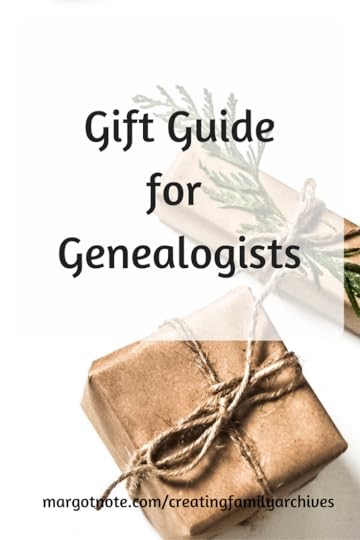
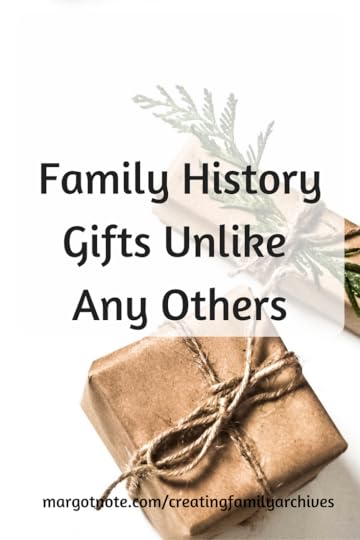
November 20, 2017
Save Your Family Recipes
Food is so much a part of our family, our culture, and our communities. The meals we share together are a way to celebrate our history. Each meal is a form of communication and communion.
In Creating Family Archives: How to Preserve Your Papers and Photographs, I use an example of my grandmothers' recipes to explain the archival concepts of provenance and original order. (Provenance is the history of ownership of an item, whereas original order refers to keeping records in the same order of classification as when they were created).
I chose this example because I grew up loving my paternal grandmother's recipes, which were mostly Lithuanian dishes. Potato pancakes, kugelis, elephant ear cookies were prepared on her teeny stove and served lovingly. Another snack she made was a matzo with margarine and peanut butter with a heart etched on top. It sounds bizarre, but it was delicious!
As Thanksgiving and the holidays approach, I wanted to create a 40-question guide that could capture these special food-related memories. I crafted a list of questions to record as much information about a favorite family recipe as possible. As you gather together over a meal, take a moment to ask about the nuances of your favorite dishes.
Interested in my other oral history kits? You can also download:
300+ Personal History Questions Workbook
Family History for Mothers Kit
Family History for Fathers Kit
50+ Halloween Memory Questions
Enter your name and email address to gain access to 40 Family Recipe Questions, as well as a subscription to my newsletter:
To learn the preservation secrets used by libraries, archives, and museums to protect their priceless materials (that you can also use for your family heritage items) read my book:
Creating Family Archives: How to Preserve Your Papers and Photographs
By Margot Note
Ready to get started creating your family archives? Here are some of my favorite products:
Follow me on Pinterest | Instagram | Twitter | LinkedIn | Facebook
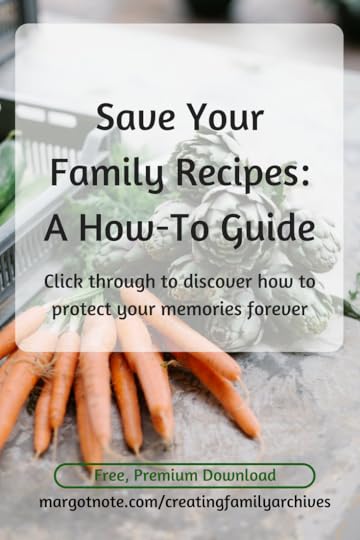
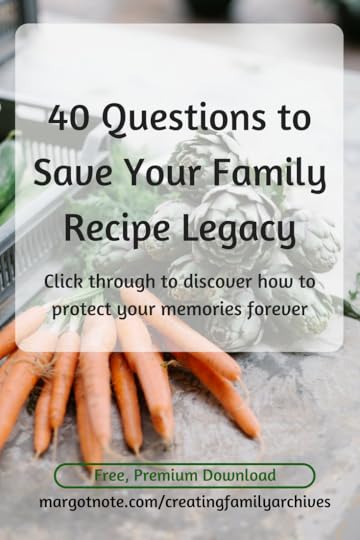
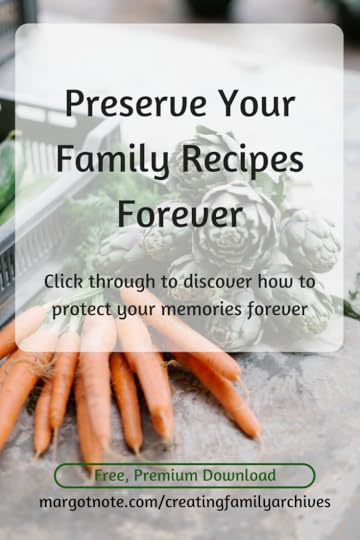
November 13, 2017
Are Your Archives at Risk?
In my book, Creating Family Archives: How to Preserve Your Papers and Photographs, I discuss the techniques that archivists use to protect historical materials from the ravages of time. I find that it's also helpful to discuss what can cause damage to your archival items. Many hazards are obvious, but others may surprise non-professionals.
Here are the major threats to papers, photographs, and other physical items:
Improper handling, either handling the documents roughly or by having them come into contact with the natural dirt and oils in your skinFluctuating or extreme temperaturesFluctuating or extreme relative humidity levels, especially high humidityHigh levels of or frequent exposure to light, especially ultraviolet rays.Pollutants such as tobacco, fireplace, or cooking smoke; dirt and dust; urban air pollutionProximity to highly-acidic documents that migrate like newspaper clippingsHarmful fasteners, like metal clips or rubber bands, and adhesivesStorage in folded, creased, or rolled conditionsStorage in acidic containers or adhesive albums, like magnetic photo albumsStorage or transport in positions that cause falling, bending, breakage, or pressingMold, mildew, rodents, insects, and animals in generalLaminationStatic electricityImproper labeling or packagingSpillage of food, beverages, or other contaminants near documentsNatural disasters such as floods, fire, and leaksTheft, vandalism, unwanted sale, dispersal, or disposalSome documents are particularly susceptible to damage. Special risk materials include:
Newspaper clippingsHighly-acidic papers such as telegrams, and scrapbook and photo album pagesCharcoal, pastel, chalk, or heavily applied pencil drawings or writingsScrapbooks, baby books, and other mixed-media albumsRare published booksPhotographsFolded or rolled documentsDocuments with fading inkEphemera, because they were created for short-term use Tapes, discs, and other recording mediaDigital items, especially if no backup systems existHave I scared you? Lists like this are what keep archivists up at night! If you are interested in learning quick, easy, and affordable ways to avoid these risks and protect your family legacy, Creating Family Archives: How to Preserve Your Papers and Photographs will provide the answers.
To learn the preservation secrets used by libraries, archives, and museums to protect their priceless materials (that you can also use for your family heritage items), read my book:
Creating Family Archives: How to Preserve Your Papers and Photographs
By Margot Note
Like this post? Never miss an update when you sign up for my newsletter:
Ready to get started creating your family archives? Here are some of my favorite products:
Follow me on Pinterest | Instagram | Twitter | LinkedIn | Facebook
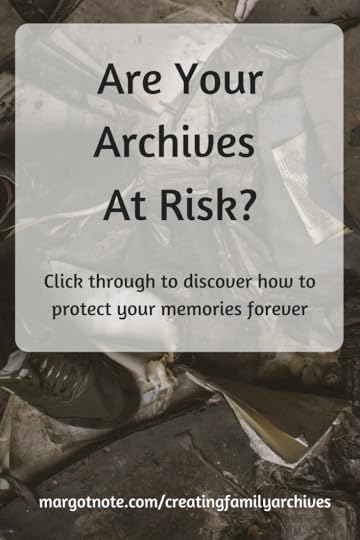
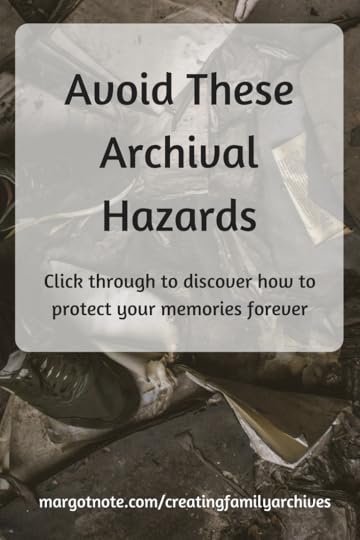
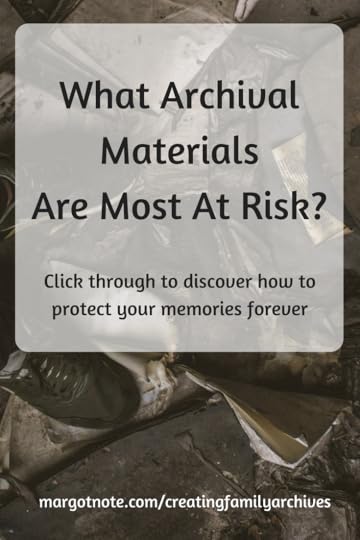
November 9, 2017
Can You Help Me?
It’s important to listen to my followers. That’s why I’m asking you to take a very short survey.
I'm planning projects for 2018 and beyond. I'd like to know what you would find helpful to preserve your legacy.
If you have a minute, please fill out the survey.
I can't wait to see your responses!
Love & Archives,

P.S. If you'd like to tell me more about how I can help you, please email me directly at margot@margotnote.com. I read and respond to all my emails and would love to hear your thoughts!
November 6, 2017
Writing a Collection Development Policy
Archives and special collection development policies should state what the organization currently holds and the collecting areas, especially records of enduring value that represent the organizations' history. A policy will not only formalize the archives program, but it will allow you to focus on what you would like to acquire as well as to disregard materials that fall outside of the collection. Focusing on what you will not collect will also allow you to deaccession materials that should not be in the collection.
The policy should be a public document, made available on the organization's website and shared with stakeholders, organizations collecting in similar areas, and with select national and international organizations.
A recent client was preparing to launch a formal archives and special collections program after years of informally collecting materials. After my two-day visit, I wrote an evaluation report to guide their work in setting up the archives with short, mid-range, and long-term goals. Step one was to write and get approved a formal collection development policy, since all other activities stem from this document.
All archives and special collection development policies should consider the following:
Under what authority does your program operate or is governed? Who makes decisions about what to accept? Major acquisitions may need approval at a high level. What is the purpose of the program?What is the history of the program within the organization? Who is your audience? Who uses your archives and special collections? What is the focus of the collection? List the subjects, people, timeframes, and geographic areas your program focuses on. Describe the kinds of materials your program collects.What formats can the repository responsibly manage?For book collections, what are your policies on editions (firsts, impressions, dust jackets, reprints, paperbacks, translations) and duplicates?How will materials be accepted into the collections? Will records be actively sought? Will collections be bought and from what funds? Who will approve acceptance of materials? Through what means will legal custody be obtained?Will loans of materials be made to other organizations and will they be accepted by your organization? Under what circumstances? What are the conditions of the loan and for its termination?Are you legally required to collect certain kinds of materials? How do you handle issues of ownership and title, copyright, data protection, and freedom of information? What materials will have limited access because of these issues?How will you handle preservation issues? Will you take items in poor condition and, if so, under what circumstances? How does this collection policy fit into the collecting policies of other libraries? Who else collects in your subjects and region? Can you work together for mutual benefit?Under what authority and circumstances will unwanted materials be removed from the collections? What procedures will be used to document this activity?How often will the policy be reviewed? Regular review can uncover issues that have caused problems, the impact of new collections, and changes in technologies and practices.What else should be included? What organizations have particularly well-crafted collection policies?
Like this post? Never miss an update when you sign up for my newsletter:
Follow me on Pinterest | Instagram | Twitter | LinkedIn | Facebook
November 2, 2017
Monster-Making: Narrative/Metanarrative in the Representation of Aileen Wuornos
In 2004, I wrote a master's thesis in History about Aileen Wuornos, who was hailed to be the first female serial killer. I examined her representations as "white trash," a lesbian, and a prostitute. When I began my project, few people had heard of her. When I completed my thesis, Wuornos had been executed and Charlize Theron had won multiple awards for her depiction of Wuornos in the 2003 film Monster. While I don't share my personal opinions in my thesis, I'll note here that I believe the first murder (against a convicted rapist) was in self-defense; the others may have been committed because she had reached her breaking point with difficult johns. Despite being a killer, I found Wuornos to be a tragic, sympathetic figure. Of everything I've written, my thesis seems to draw the most comments, queries, and citations, so I've made it available here.
From the Preface:
Aileen "Lee" Carol Wuornos, forty-six, died of a lethal injection at Florida State
Prison on October 9, 2002. She was the fifty-second person executed since Florida's
reinstatement of the death penalty and the third female execution in the state's history.
Eight hundred and five prisoners have been put to death in the United States since
1976, more than half since 1997. In response to the increase in state killings, the
American public has grown less interested in death penalty cases. As a result, news
coverage of executions has become inconspicuous. Wuornos's execution, however,
offered the media the opportunity to recount her final hours for an eager audience. The
public was informed that she declined her last meal and spent the night reading the Bible,
listening to the radio, and meeting with documentary filmmaker Nick Broomfield and
with her lifelong friend Dawn Botkins. Botkins told correspondents, "She was looking
forward to being home with God and getting off this Earth. She prayed that the guys she
killed are saved.... She was more than willing to go. It was what she wanted."
Florida Governor Jeb Bush signed her death warrant on October 2, 2002, after
psychiatrists found Wuornos competent for execution. Her death was timely--a month
before Bush's gubernatorial re-election bid--and controversial as well: four months
prior, the Supreme Court ruled that only juries should decide whether to sentence inmates
to death. In Florida, judges make the decision after a recommendation from the trial
jury. However, the Supreme Court's ruling did not prevent Wuornos's execution because
she confessed more than ten years before, volunteered for execution, and fired her appeal
lawyers.
Her cryptic final statement was, "I'd just like to say I'm sailing with the Rock and
I'll be back like Independence Day with Jesus, June 6, like the movie, big mother ship
and all. I'll be back." After an injection of potassium chloride, Wuornos took sporadic
shallow breaths, and her skin slowly turned ashen. She was pronounced dead at 9:47 a.m.
Terri Griffith, a daughter of one of the victims, told reporters, "She got an easy
death. A little too easy.... I think she should have suffered a little bit more. Use the
electric chair. Let her legs kick and smoke come out of her ears."
Download Monster-Making: Narrative/Metanarrative in the Representation of Aileen Wuornos.
October 30, 2017
An Archival Processing Project for a Famous Author
As an archives consultant, it is difficult to explain to people what I do for a living. Describing what an archivist does is hard enough, but adding the extra layer of consulting makes an elevator pitch nearly impossible!
My projects are split between work at home and on site. The virtual work consists of writing, researching, writing grant reports, and photo researching and editing. These projects are straight-forward and don't lend themselves to dramatic before and after pictures. No, so with my on-site work!
I want to share with you a recent project I completed to illustrate the work that I do for my clients. To keep anonymity, I will refer to the players in this project as the Author, the University, and the Broker.
I was hired by the Broker to rehouse and catalog roughly 100 linear feet of the Author's literary archives, located in two storage lockers in a self-storage warehouse in the Lower East Side. Organizing and inventorying the materials allowed for a better determination of the collection’s breadth, content, and context, and ultimately a smoother transition to the University's collections. The University would buy the archives once the work was completed.
The materials included notebooks and journals; manuscripts; files including some manuscripts and correspondence; printed matter, including early material; and unsorted bins. Also included were computers and storage media and A/V materials including U-Matics, VHS tapes, CDs, and audio cassettes.
I was familiar with the Author's work, so that added a layer of curiosity to the project. As a writer myself, I always like to discover the processes that writers use in the creation of their work.
My scope of work included rehousing the collection in archival folders and boxes. The University was particular about the type of supplies it needed, so the Broker bought the supplies before I began work and then later in the project.
I created an inventory that enumerated boxes and their contents, with concise descriptions and date ranges for each box. The descriptions ranged from box-, folder-, or item-level, depending on the boxes and their contents.
I used the University's template that transferred the spreadsheet into Encoded Archival Description (EAD), a standard used for encoding finding aids online. Using the template accelerated the University's ability to repurpose my work for accessioning and processing.
In layman's terms, I would be entering information about the contents of each box which would later be uploaded into a database and be immediately available. The final spreadsheet was over 2000 lines, which would be a lot of work if someone had to reformat it by hand. Using the University's template saved hours of labor.
I also noted in the inventory which boxes contained audiovisual materials or electronic media, without removing them from their locations to retain their context.
The University is known for buying a lot of archival collections, and my initial pass at processing, arrangement, and description would allow for the University to have some physical and intellectual control of the collection at the time that it was purchased. Parts of the Author's collection were in such a state that I could only organize them to a small degree. In time, the University will process the collection more fully, hiring someone with grant funding to work solely on that collection for years.
My initial estimation of the project is that it would take about three weeks or 100 hours to complete. I was accurate with my estimation, but there were some days that I was unable to work because I was waiting for the archival supplies to be delivered. If I had to do the project again, I wouldn't have started until all the supplies were delivered to the warehouse.
Before I wrote my proposal for the project, I visited the warehouse to view the storage units. Here are some pictures from that day:

Fifth floor storage unit, left side. Boxes were piled to the ceiling.
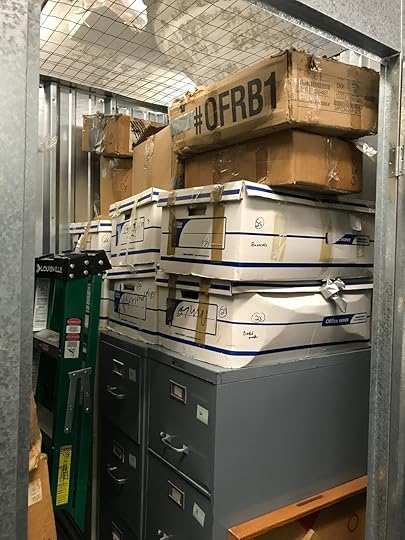
Fifth floor unit, right side. The filing cabinets were all full of material as well.
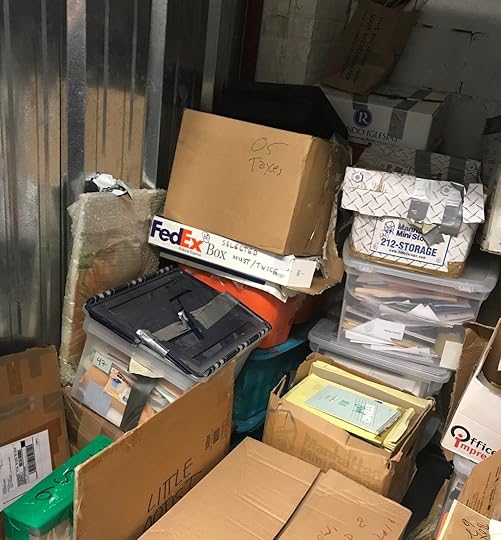
Second floor unit: boxes, bins, and bags.
I cropped some of the photos to hide identifying details, but you can see that there was a lot of work to be done!
Due to the state of the boxes and their volume, I had to work on site in the warehouse. This was, admittedly, my least favorite part of the project. The warehouse wasn't climate controlled so it was hot, dusty, and stuffy. I got used to it, but I had to make sure that I took breaks and kept hydrated. I reduced my Crossfit classes during this project because I was lifting and arranging so many boxes that I didn't need a workout!
I had to pack up every time I used the bathroom or went out to lunch. I found out early in the project that people lived in the facility; they kept to themselves, but I was concerned for my safety.
At times, it was eerie to work there. It didn't help that I love true crime podcasts! One time I found myself listening to the Jonestown Massacre Death Tapes on speaker, which echoed among the lockers. I quickly switched to Iron Maiden to lighten the mood. The people who lived there were probably happy when the project was over and the creepy girl finally left!
Here's a picture of me on my first day, working through the boxes. I wore a dust mask initially because things hadn't been moved in awhile. As I worked, I no longer needed it. I either got used to the dust or much of it blew away as I worked.
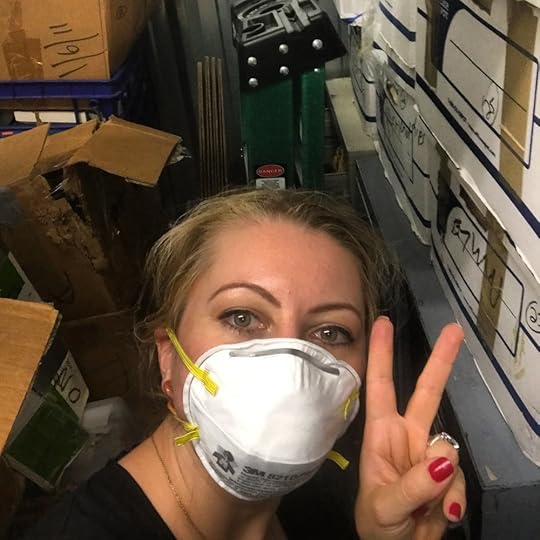
A processing selfie
Each day, I set up a folding table and chair, opened my laptop, and arranged supplies. Then I pull out boxes, inventoried them, refoldered their contents, and rehoused them in archival boxes. I threw away the old boxes and folders at the end of each day, which was often quite significant.
I got on friendly terms with the freight elevator guys. They both separately found my set-up as they were sweeping and said, "Whoa!" because I was among so many boxes!

In the middle of the project.
Due to the space limits of the unit and the hallway in which I worked, I often had to pull out most of the boxes from the units.
At times, I felt like I was in a giant game of Tetris. Some boxes were a simple transference with refoldering and reboxing into the new boxes. Some of the larger, legal-sized boxes were split into two letter-sized boxes. I often had to move boxes between the second and fifth-floor unit at the end of my workday. I somehow always managed to pile everything into those two units!
Some materials already had some distinguishing order to them, such as a box which originated as a filing cabinet drawer. Others were more like Warhol's time capsules where materials were piled on top of each other in plastic containers. I tried to find the order there as best I could. The Author kept manuscripts from students, friends, and colleagues. For masses of papers where I couldn't determine authorship, I left them unfoldered in the boxes. These instances were marked in the scope and content note column on the spreadsheet. The University was aware of these sections and agreed that this was the best solution for now.
Throughout the project, I communicated to the Broker and my contact at the University to keep them updated and ask questions.
Here's what I learned from the project:
Writers (even famous ones) don't make a lot in royalties. This Author made the equivalent of what I have made on my books per publisher, but s/he had many more deals with different distribution channels.It's important to take breaks. During long days, I promised myself that I would have a sit-down lunch in nearby restaurants. One day, Michael Kelly (Doug Stamper on House of Cards) and Constance Zimmer (Quinn King on Unreal) were having lunch the same time I was. This made my day. You'll always find interesting items when processing people's collections. Just when things are getting monotonous, BLAMO! you'll find something out of the ordinary. I put aside anything I thought would be too personal and had nothing to do with the Author's oeuvre, such as medical, legal, and tax records, in specially marked boxes. The Author will pick these up after the University picks up the rest of the boxes. Scheduling time for this project was important. A lot of my day was spent traveling back and forth to the location as well as setting up and breaking down each day. On warehouse days, I couldn't have meetings with clients (too dirty and sweaty) or take client calls (no reception). I couldn't work on other projects either because of my limited time. I found ways to block my other responsibilities into non-warehouse days. I also found that I worked more efficiently if I switched between days devoted solely to this project and days spent on my other work.In total, there were 100 boxes of material, all neatly organized, and inventoried with precision. Here are the after shots. Is there nothing more beautiful?
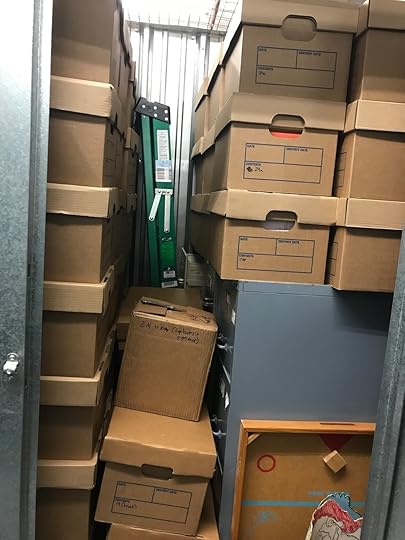
Fifth floor unit after project completion.

Second floor unit after completion; everything not in a Paige Miracle Box will be kept by the Author.
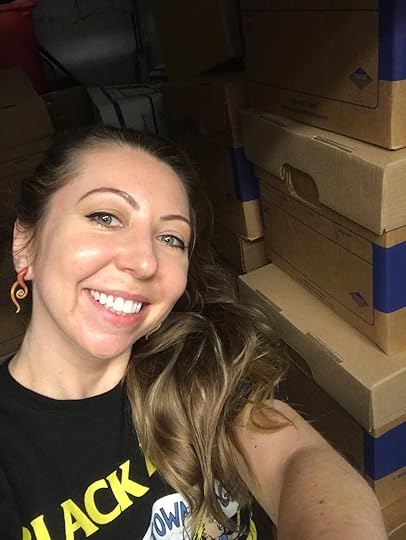
One happy archivist: I'm glowing with pride and SWEAT!
What a challenging, but fulfilling and fun project! It was a win-win for all players. I got a project that provided me with some hands-on archival work. The Broker got an experienced archivist who could turn the collection around quickly and be on call for future projects. The University got someone whom they knew and trusted, who had an attention to detail only a professional archivist has.
Do you have a project that needs archival processing? Contact me at margot@margotnote.com, and let's start a conversaton.
Like this post? Never miss an update when you sign up for my newsletter:
October 26, 2017
Site/Sight as Text: Barthes and Zero Degree Architecture
A version of this paper was originally presented at The Renaissance of Roland Barthes conference, presented by the Center for the Humanities, The Graduate Center, CUNY on April 25, 2013. The paper was later published in The Conversant.
Barthes is so versatile. Camera Lucida is, of course, how most people are introduced to him (as I was through my work with photographs). Yet, his oeuvre--novel/essay, literary/cultural texts, and critical theory--can be used as a lens for so many topics of scholarship.
Photographs are artifacts of moments past and forever lost. They provide a “fugitive testimony” to history (Camera Lucida 93). Throughout his work, Roland Barthes examines photography’s mnemonic features that testify to the absence of the subject depicted while simultaneously giving evidence that it existed. Barthes regards architecture as a visible index to the past and explains that ancient societies built structures to immortalize themselves. He writes, “memory, the substitute for life, was eternal and that at least the thing which spoke Death should itself be immortal: this was the Monument” (93). Photographs as “natural witness[es] of ‘what has been’” have replaced monuments (93). As handmaidens of memory, they stand in place for structures that no longer remain. Barthes notes that historical photographs have a “defeat of Time in them: that is dead and that is going to die” (96). Thus, images articulate an anterior future tense as they conjure the past, present, and future concurrently. Susan Sontag observed that photographs, akin to monuments, become more desirable through the passage of time. Both acquire an aged look and a detachment from the prosaic that enhances their aesthetic value (Sontag 79-80). Photography forges a symbiotic relationship with architecture. Through one artistic medium, another is better understood.
In addition to Barthes’s fascination with photography, the motif of the empty sign, the neutral, and the degree zero appear throughout his work. He describes degree zero as “a still center, an erotic or lacerating value” (Camera Lucida 18). The empty sign and the neutral, too, are areas irreducible to positive or negative terms and not yet appropriated by myth. In his first book, Writing Degree Zero, Barthes lauds authors who “create a colorless writing, freed from all bondage to a preordained state of language” (79). As an example, Barthes recognizes Albert Camus’s The Stranger for its “transparent form of speech” (82). He describes its style as “neutral,” “inert,” and “degree zero.” He states that the writing “remains wholly responsible, without being overlaid by a secondary commitment of form to a History not its own” (The Rustle of Language 64). In other words, zero-degree writing is free from signification. Similarly, the empty sign is defined in Empire of Signs as “the interstice without specific edges” (26). The form the sign takes vacates meaning. This theme continues in Barthes’s writing until the end of his career, during the preparation for his lecture course The Neutral. Barthes defines the neutral as “every inflection that, dodging or baffling the paradigmatic, oppositional structure of meaning, aims at the suspension of the conflictual basis of discourse” (211). Rosalind Krauss and Denis Hollier assert that the neutral was not a new idea for Barthes, but “held steady . . . over the trajectory that took him from Writing Degree Zero, with the zero degree an early version of ‘le neutre,’ through all the rest of his books” (xiii).
The lack of significance offered by the empty sign is especially apt when applied to buildings and the urban environment. Although Barthes is not as well known for scrutinizing architecture as systematically as literature or fashion, he recognizes signs wherever they are. He challenges the “naturalness” of cultural texts that are capable of producing all sorts of supplementary connotations. Barthes recognizes architecture as an intellectual activity that utilizes history, theory, and criticism. He explores the history of cities; the social, political, and economic interactions within built environments; and the cities’ relationship to their regions. He perceives the city as a repository of signs through its streets, monuments, and edifices. The urban space becomes a signifying vehicle itself. Architecture and its images provoke a degree zero, an empty sign, and the neutral within Barthes.
Scholarship on Barthes’s writing has not fully recognized his contribution to the field of architecture, which this essay explores. In what follows, I shall situate Barthes’s shifting ideas of place as degree zero relative to three phases: structuralism in “The Eiffel Tower,” poststructuralism in Empire of Signs, and phenomenology in Camera Lucida. “Shifting” is the key word here, as Barthes’s work covers a diverse range of fields, and his theoretical development evolved over time and lacked boundaries between phases. In the course of his career, his intellectual stance transitioned from a structuralist outlook to a more overtly poststructuralist perspective. In his later work, while not abandoning his viewpoints entirely, Barthes embraces phenomenology, a position in which he considers semiological experience in light of poststructuralist realizations.
Throughout his oeuvre, whether examining Paris, Tokyo, Granada, or Jerusalem, Barthes regards sites as texts eternally open to interpretation. Viewers read the urban environment that lies in front of them or is experienced through the photographic medium. Oscillating between dream and function, architecture and its simulacra have the potential for limitless meaning as they reflect the fugitive nature of real experience, the communicative power of photographs, and the magnitude of humankind’s monumental endeavors.
I. Deciphering the Panorama“The Eiffel Tower,” published in the United States in 1979 in The Eiffel Tower and Other Mythologies, was first written in the mid-1950s. It is part of Barthes’s structuralist period, in which he advocates for a systematic, scientific approach to cultural phenomena. Structuralism, for Barthes, evolved from the work of Ferdinand de Saussure. The Swiss linguist and semiotician offered a dyadic model of the sign, consisting of the signifier, the form that the sign takes, and the signified, the concept it recalls. The sign results from the association of the signifier with the signified, and the relationship between the two is signification. As a critical approach, structuralism focuses on the rules and codes of systems and studies the structure out of which texts emerge, not the texts themselves. Barthes applies structuralism’s scientific approach to demystify traditional notions of meaning. He uses structuralism to critique society through the demonstration of its often concealed reliance on artificial sign systems.
The Eiffel Tower was built as photography became technologically advanced and affordable. The tower appealed to photographers because of its combination of materiality and immateriality. Rather than being constructed by traditional methods, its erection was an achievement of modern engineering. In The Arcades Project, Walter Benjamin states of its creation, “one hears no chisel-blow liberating form from stone; here thought reigns over muscle power, which it transmits via cranes and secure scaffolding” (161). Today, the tower is one of the most recognizable monuments in the world and the most photographed (see fig. 1). It evolved as a symbol of Paris and metropolises in general, due in part from its role as the entrance to the 1889 World Fair. In The Dialectics of Seeing: Walter Benjamin and the Arcades Project (1989), Susan Buck-Morss notes that world fairs promoted progress, nationalism, and utopian goals through technology. By extension, the tower also manifested these attributes as a universally recognized urban icon. Barthes writes in his diary about presenting a gift to a hustler he met in his travels: “What sort of pleasant trifle can you give someone who is totally indigent? . . . I opt for a coded . . . excessively useless souvenir: a brass Eiffel Tower” (Incidents 24).

Fig. 1. A view of the Eiffel Tower from the Champ de Mars. CC BY 2.0 by Terrazzo.
The tower represents a modern Paris, transformed by Georges-Eugène Haussmann during Emperor Napoléon III’s reign with efforts ending in 1927. His public works program annexed suburbs; removed medieval neighborhoods; built boulevards, parks, and squares; and constructed new sewers and aqueducts. Paris’s street plan and distinctive center resulted from Haussmann’s renovation campaign. Barthes notes ironically that as modernity decimated buildings, a modern process—photography—allowed them to be recorded for posterity.
Despite Gustav Eiffel’s efforts to justify his structure in terms of utility, the tower was built without any use, but with an edifice that appeals to the imagination. Barthes writes:
Wherever you are, whatever the landscape of roofs, domes, or branches separating you from it, the Tower is there; incorporated into daily life until you can no longer grant it any specific attribute, determined merely to persist, like a rock or the river, it is as literal as a phenomenon of nature whose meaning can be questioned to infinity but whose existence is incontestable (“The Eiffel Tower” 3).
As a signifier free of any fixed referent, writes Barthes, “this pure—virtually empty—sign—is ineluctable, because it means everything” (4). The “zero degree” tower attracts meaning like “a lightning rod attracts thunderbolts” (7, 5). Barthes attempts to explain how something can be itself and the medium through which ideology propagates itself at the same time. How felicitous it must have seemed to him when in 1964, the year the essay was first published, France’s Ministry of Culture declared the Eiffel Tower a historical monument.
Barthes finds that the tower provides a vantage point from which architecture can be read. The tower is the iconic axis of a reciprocal system, at once a receptacle of all gazes in the city and a universal point of view overlooking Paris. The only way to negate the monument is to be inside it. Studied by all, it is also an object for observation. The tower, thus, “transgresses this habitual divorce of seeing and being seen” (“The Eiffel Tower” 5). While the tower symbolizes many concepts, such as travel, modernity, and communication, Barthes notes that it holds a “major symbolic function . . . which is its final meaning:” the gaze that deciphers Paris (8). Functioning as a balcony, it offers a panoramic vision:
The Tower makes the city into a kind of nature; it constitutes the swarming of men into a landscape . . . To visit the Tower, then, is to enter into contact not with a historical Sacred, as is the case for the majority of monuments, but rather with a new nature, that of human space (8).
Barthes notes that the tower gives one a breathtaking vista of Paris, but that belvederes look out upon nature. The tower transforms the city into a landscape, providing an aerial view that allows visitors to read the text of Paris (see fig. 2). The structure of the urban space now becomes visible through the panorama that Barthes defines as:
An image we attempt to decipher, in which we try to recognize known sites, to identify landmarks. Take some view of Paris taken from the Eiffel Tower; here you make out the hill sloping down from Chaillot, there the Bois de Boulogne; but where is the Arc de Triomphe? You don’t see it, and this absence compels you to inspect the panorama once again, to look for this point which is missing in your structure (10).

Fig. 2. A panoramic view of Paris from the northwest as seen from the Eiffel Tower. CC BY 2.0 by Alexander Kachkaev.
Barthes continues, “the bird’s eye view . . . gives us the world to read” (9). The tower observer becomes an interpreter of the urban landscape. It is laid out as a text to be examined “in their structure,” which he notes as “geographical, historical, and social” (9, 13). Therefore, “Every visitor to the Tower makes structuralism without knowing it” (9). Paris, as a city so familiar to Barthes, can be read and deciphered through its scenic tableau or its many photographic representations. He argues that among the multiplicity of meanings that the cityscape and its architecture can hold, a hierarchy of signification exists: its panoramic function. One meaning, above all others, is more prominent.
II. Circling the City CenterWhen visiting Tokyo, however, Barthes’s beliefs on the stratification of the meaning of the neutral changes significantly. In Empire of Signs, Barthes interprets Japanese culture as a utopia of signifiers, finding freedom from the occidental obsession with meaning. In Barthes’s poststructuralist phase, which emerged in the late 1960s during his trip to Japan and became fully apparent in the book’s publication in 1970, his need to explain signs is surpassed by “a desire to disrupt and decenter their authority” (Trifonas 3). Poststructuralism rejects many of the assertions of structuralism, chiefly its claims of the fixity of the relationships between signifiers and signifieds. Signifiers remain stable, but signifieds—in this case, the built environment of the urban space—are transient. Barthes demonstrates how a culture outside of the system of the Western world dismantles preconceptions about signs and meaning. In this work, Barthes seeks out and celebrates the instability and emptiness of signs.
Tokyo inverts the conventional reading of metropolitan areas. The city provides an antipode to the development of European capitals, which have a set of symbolic relationships to landmarks that provide meaning. Haussmann’s renovation of Paris, for example, was a radical reorganization of the urban space to bring greater meaning and use to it. In contrast, Tokyo seems incomprehensible to Western sensibilities because its structure is different. The city’s organization dates from the Edo period (1600 to 1868) when the royal palace was an axis from which districts of lessening importance radiated. The palimpsest of modern Tokyo confounds fixed categories and exempts itself from the Western compulsion to categorize.
The othering of the East relates to the ethical and political problems of Orientalism. When examining Barthes’s writing on cultures tied to the dominating authority of the West over the East, Diana Knight questions how self-aware Barthes is of his own Orientalist tendencies. In Empire of Signs, she argues that Japan is “self-consciously and explicitly presented as a utopia” and a “fantasized utopian civilization” (Knight 625). Barthes does not wish to produce a cultural analysis of Japan. To do so would merely repeat the myth of the Orient, from which no Westerner is exempt. Instead, Barthes locates himself within the ethnocentrism that the concept of Japan stimulates in the occidental reader.
The country Barthes writes about is less the subject of the account of his trip abroad than a point of departure. For him, Japan is a fictive nation and a semiotic system where artifice reigns and meaning abandons forms. Barthes writes:
the public place is a series of instantaneous events which accede to the notable in a flash so vivid, so tenuous that the sign does away with itself before any particular signified has had time to “take.” One might say that an age-old technique permits the landscape or the spectacle to produce itself, to occur in a pure significance, abrupt, empty, like a fracture. Empire of Signs? Yes, if it is understood that these signs are empty, and that the ritual is without a god (Empire of Signs 108).
Barthes’s version of Japan serves as an occasion to play with signification through writing, a liberation from the structuralist limits of meaning. Tokyo, unlike Paris and its tower, resists the image. Barthes writes, “The author has never, in any sense, photographed Japan” (4). Instead, he describes his experiences of discovering Japan as identical to the practice of reading a text:
Japan has afforded him a situation of writing. This situation is the very one in which a certain disturbance of the person occurs, a subversion of earlier readings, a shock of meaning lacerated, extenuated to the point of its irreplaceable void . . . Writing . . . creates an emptiness of language. And it is also an emptiness of language which constitutes writing (4).
Tokyo, occupied by the lacuna of the royal palace, has a vacant center. Its subway map shows routes orbiting around an empty node marked by emerald (see fig. 3). Urban activity rotates around this area, yet does not enter it. The outlook inside the palace grounds is a verdant vacuity surrounded by a cluster of high-rises (see fig. 4). The city is not organized around a guaranteeing truth, but a neutral area designated by arbitrary signs. Barthes writes:
The entire city turns around a site both forbidden and indifferent, a residence concealed beneath foliage, protected by moats, inhabited by an emperor who is never seen, which is to say, literally, by no one knows who. Daily, in their rapid, energetic, bullet-like trajectories, the taxis avoid this circle, whose low crest, the visible form of invisibility, hides the sacred “nothing” (30).
Barthes finds that this emptiness holds true for many cities, which are necessary voids encapsulated by the urban landscape.

Fig. 3. Subway map of Tokyo, with the Imperial Palace area marked by green.CC BY-NC 2.0 by Stuart Rankin.

Fig. 4. View of the skyscrapers of Tokyo from the grounds of the Imperial Palace. CC BY-NC-ND 2.0 by Alex Masters.
In “Semiology and the Urban” (1971), an essay that was written at the same time as Empire of Signs and mentions Tokyo, Barthes emphasizes the indeterminacy of urban landmarks, noting the necessity for absent centers and empty signifiers. Urban life offers an eroticism where different types of people interact. Barthes argues that the city is “the site of our encounter with the other,” and “it is for this reason that the center is the gathering point of any city,” especially for the young (“Semiology and the Urban” 170). Urban dwellers walk through the streets, creating their own erotic language. Barthes notes, “The city is a discourse and this discourse is truly a language: the city speaks to its inhabitants, we speak our city, the city where we are, simply by living in it, by wandering through it, by looking at it” (165). Tokyo mystifies Barthes because it lacks a structure he recognizes. Its discourse stymies him, and its language is incomprehensible. As a cultural outsider, he discovers that the meaning of the city is nil.
Barthes’s trip to Japan is a turning point for his understanding of architecture and the empty sign. In Tokyo, signs exist for their own merit, retaining only the significance instilled by signifiers. Conversely, the Parisian culture Barthes dissects in “The Eiffel Tower” priorities specific levels of meaning—the panorama—over others. How each perspective positions signs defines the difference between structuralism and poststructuralism: one stance sees meaning as stratified and hierarchical, while the other resists meaning entirely.
III. Memorializing the LandscapeIn Camera Lucida (1980), Barthes further refines his thoughts about the empty sign, degree zero, and the neutral in the context of photography. The book departs from his previous work without eschewing it. Instead, he retreats from semiotic and structuralist analysis and examines the visceral effect of photographs. He finds that some images touch him emotionally while others have no effect. Images “animate” him, and engagement with them becomes an “adventure” of photography (Camera Lucida 19). Barthes declares himself the “mediator for all Photography” who is “determined to be guided by the consciousness of my feelings” (8, 10). In previous works, S/Z (1970) most notably, Barthes argues that interpretations of texts are not based on personal experience, but the articulation of coded systems. Camera Lucida, however, unites the self and social codes and reaffirms the centrality of the individual in constructing meaning. He sees experience as primarily beyond conventions and cultural codes.
Camera Lucida offers a phenomenology of the photographic picture. Originating from German philosopher Edmund Husserl, phenomenology examines the ways that the construction of consciousness permits it to reference objects beyond itself. It studies consciousness as experienced from a subjective point of view. According to its dedication, Camera Lucida was written in homage to Jean-Paul Sartre’s The Imaginary: A Phenomenological Psychology of the Imagination (1940), which introduced phenomenology to France during Barthes’s youth. Barthes “borrowed something from phenomenology’s project and something from its language” (Camera Lucida 20). He bases the phenomenological character of his investigation on his own understanding of the medium and studies the photograph as an experienced object. He describes his approach to photography as “a vague, casual, even cynical phenomenology” (20). His phenomenology is one that, unlike classical phenomenology, emphasizes physicality, desire, and mourning. He writes, “The anticipated essence of the Photograph could not, in my mind, be separated from the ‘pathos’ of which, from the first glance, it consists” (21). Barthes’s phenomenological study considers architecture and its visual simulacra as carriers of temporality and death. To him, photographs are opportunities to meditate on time, memory, and loss.
Camera Lucida takes its title from an optical device for looking through a prism at a subject while drawing it. By viewing the scene and drawing surface simultaneously, the user can render an image with an accurate perspective. Before the invention of photography, the apparatus was used to sketch buildings and landscapes. The image the instrument conjures can be seen only in the mind’s eye. Photographs act as a camera lucida in reverse. Viewers read from the two-dimensional image the three-dimensional reality that lies in the past.
The camera lucida evokes the Winter Garden photograph of Barthes’s mother as a child, discussed at length in the book, but unpublished. He discovers the snapshot as he browses through family pictures, “gradually moving back in time with her, looking for the truth of the face I had loved” (Camera Lucida 67). Barthes describes the image as faded and sepia-toned with blunted corners from when it was in an album. The photograph, taken in 1898, depicts his mother, aged five, standing next to her seven-year-old brother. She shyly holds one of her fingers with her other hand. They pose on a small wooden bridge in a conservatory dedicated to the cultivation of winter-blooming plants at their childhood home in Chennevières-sur-Marne, France.
Only Barthes can see his mother in the chambre claire of a glass conservatory. Readers project their own images into the photographic void. While some scholars do not believe that the photograph exists, Barthes’s excuse for withholding it is telling (Knight 244-69; Olin 81). Barthes explains that the image is so mundane it is unpublishable: “For you, it would be nothing but an indifferent picture, one of the thousand manifestations of the ‘ordinary’” (Camera Lucida 73).
For Barthes, the “essence” of photography lives in his mother’s image (Camera Lucida 73). He decides to “‘derive’ all Photography (its ‘nature’) from the only photograph which assuredly existed for me, and to take it somehow as a guide for my last investigation” (73). The Winter Garden image, written about, but unseen, functions as an empty sign. The conservatory depicted within the photograph, and from which the picture derives its name, is a building degree zero. The image at the heart of Camera Lucida—and at the center of Barthes’s writing—is an aperture and an absence. This architectural photograph is the emptiest of signs.
According to Barthes, photography represents the juncture of sign and body, meaning and materiality. Barthes dwells upon the relationship between photographs and the body because corporeal sensations are a way to experience built and natural environments. His bodily responses to photographs act as a measure of photographic information. He describes what a photograph looks like, but also how it feels. Barthes develops dual photographic concepts: studium and punctum. Studium denotes the photograph’s cultural, linguistic, and political impressions. The punctum refers to the emotional detail that creates a relationship between the subject and the observer. The punctum is often body-based, such as Warhol’s nails, a boy’s teeth, or the feel of a dirt road that a violinist plays on that Barthes “recognize[s] with my whole body” (Camera Lucida 45). He writes that photography reaches across time and space: an “umbilical cord links the body of the photographed thing to my gaze,” a transmission of the past (81). He continues, “From a real body, which was there, proceed radiations which ultimately touch me . . . a carnal medium, a skin I share with anyone who has been photographed” (81). With images, the universal meets the personal at the locus of the body.
The corporeality of architecture can be applied to Charles Clifford’s image of the Alhambra in Granada, Spain, the only photograph of a building reproduced in Camera Lucida (see fig. 5). Published in a book primarily composed of portraits and group shots, the image stands out as the lone representation of architecture. Barthes inhabits the Alhambra through Clifford’s photograph, an image that depicts otherness much like his musings on Japan in Empire of Signs.
![Fig. 5. Clifford, Charles. [The Alhambra, Granada. The Wine Tower]. 1862. Photograph. The Metropolitan Museum of Art, New York.](https://i.gr-assets.com/images/S/compressed.photo.goodreads.com/hostedimages/1509118722i/24292945._SY540_.jpg)
Fig. 5. Clifford, Charles. [The Alhambra, Granada. The Wine Tower]. 1862. Photograph. The Metropolitan Museum of Art, New York.
Clifford, a Welsh photographer who spent his professional career in Spain, opened his first photographic salon there in 1850. He photographed all over the country, specializing in landscapes, architecture, and public works. Recognition of his efforts resulted in civic commissions such as improvement projects in Madrid and the construction of an aqueduct system to bring water into the country’s capital. He exhibited his work in Britain and France, where over 400 of his photographs were shown at the 1856 Paris Photographic Salon. Clifford later worked in the service of Queen Isabella II from 1858 onwards and accompanied her on royal visits.
The Alhambra, first built in 889, has a long record of falling into ruin and being rebuilt over the centuries. A majority of the work was commissioned by Ibn al-Ahmar, founder of the Nasrid dynasty, in the thirteenth century. A palace-citadel with official and residential chambers, a bath, and a mosque, its most renowned features are its courtyards with elegant arcades, fountains, and light-reflecting pools. Celebrated for its exceptional expression of Moorish and Andalusian culture, the Alhambra conveys the history of the religious and cultural changes to the region through its architecture. When Clifford photographed it, Victorian scholars and travelers had rediscovered it as a muse for art and literature.
Barthes describes Clifford’s photograph as “an old house, a shadowy porch, tiles, a crumbling Arab decoration, a man sitting against the wall, a deserted street, a Mediterranean tree” (Camera Lucida 38). Examining the photograph closer, one sees a gated cemetery with three white crosses in the background. The image literally represents death. Whether Barthes recognized this is unknown, but the image certainly evokes Orientalism in himself similarly to his experiences in Japan. He questions why the photograph induces desire: “warmth of the climate? Mediterranean myth? Apollinism?” (38). While nineteenth-century photographers like Clifford were drawn to remote locales because of their strong light and promise of shorter exposure times, the imperialist and Orientalist aspects of their portfolios cannot be lost to their audience. Working in a region that lacked indigenous photographers, Clifford, as a photographic colonist and ethnographer, made his living by documenting the Oriental wonders of Spain and presenting them to British and French audiences.
Of this image, Barthes writes, “it is quite simply there that I should like to live” (Camera Lucida 38). He continues, “Photographs of landscape (urban or country) must be habitable, not visitable” (38). The building captures his imagination and invokes a sense of adventure and passion, a feeling of “having been there or of going there” (40). Since Freud said that the maternal body is the only place one can claim to have been for certain, Barthes’s interest in the image indicates how he yearns for his recently deceased mother. The photograph symbolizes home, a gateway, a womb, a tomb, or the dark chamber of the camera obscura: an empty sign.
Reflecting on one of Auguste Salzmann’s photographs, taken near Jerusalem in 1854, Barthes again discovers the tangible aspects of the built environment (see fig. 6). The French Ministry of Public Instruction supported Salzmann’s trip to the Holy Land to confirm controversial dating of monuments by documenting architectural styles in the region (Berg 4). Although his journey was cut short by illness, he created 150 calotypes of historical monuments in Egypt and Jerusalem. Despite his pioneering accomplishments as an artist, by 1857, Salzmann preferred to be known as an archaeologist, rather than a photographer (Heilbrun 121).
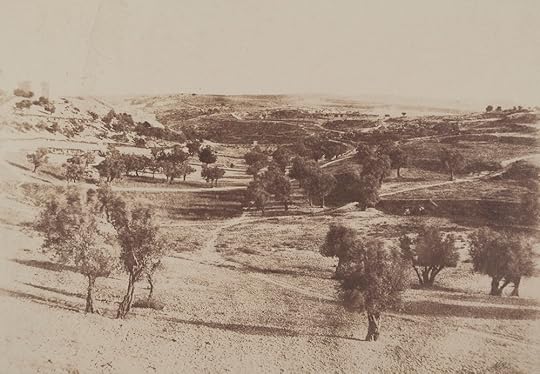
Fig. 6. Salzmann, Auguste. Jérusalem, Chemin de Beit-Lehem. 1854. Photograph. The Metropolitan Museum of Art, New York.
Salzmann’s photograph of a road to Bethlehem is, according to Barthes, “nothing but stony ground, olive trees,” an empty sign ready for inhabitation (Camera Lucida 97). Given that the Second Empire was a period of increased French colonial expansion, Abigail Solomon-Godeau notes, “showing so much of the world to be empty was unconsciously assimilated to the justifications for an expanding empire” (159). Emmie Donadio notes that early photographers accompanied archaeologists to photograph objects too large to bring back to Europe. Salzmann’s photograph is not an objective record, but a claim to the area. A Western audience reads the glories of past civilizations, the drama of ruined architecture, and the spiritualism of biblical associations into the image and others in Salzmann’s portfolio.
Through the imperialist lens, observers can easily project themselves into the landscape. The photograph leads Barthes to question how photography influences the perception of time as it marks the present of the viewer looking at the image, the moment when the photograph was taken, and the historical past of the subject pictured. As Barthes explains, Salzmann’s photograph represents both 1854 and the era of Christ. The image is a “certificate of presence,” yet it looks backwards, a “prophecy in reverse” (Camera Lucida 87). It brings the past to the present.
While photographs speak to temporality, they ultimately refer to death. Photography’s threnodic nature runs throughout Camera Lucida. Barthes wrote the book as he mourned his mother, and as the final book published in his lifetime, it is his last word on photography. While examining the Winter Garden photograph, Barthes realizes his mother’s life is still to be lived:
In front of the photograph of my mother as a child, I tell myself: she is going to die: I shudder . . . over a catastrophe which has already occurred. Whether or not the subject is already dead, every photograph is this catastrophe (Camera Lucida 96).
Photographs are “the return of the dead” and “flat Death” (9, 96). They represent the passing of time and signal the mortality of the viewer, which Barthes calls the “imperious sign of my own death” (97). At the time of the book’s publication, digital images were beginning to displace analog’s fundamental properties as tangible imprints of reality. Photography’s “demise” was predicted by its own success and the introduction of digital technologies that aided in the manipulation of images. Barthes states in Camera Lucida that photography “has already disappeared. I am . . . one of its last witnesses . . . and this book is its archaic trace” (94). Photography’s relationship to time and its capture of fleeting moments correlate to the desire to overcome death, be it photography’s, Barthes’s mother’s, Barthes’s, or our own.
The phenomenological effect of images captivates Barthes, especially images that evoke desire or mourning. Photographs of the Winter Garden, the Alhambra, and the road to Bethlehem become vehicles of meaning. They contain a despair and a corporeality that move Barthes to respond to them emotionally. In “The Eiffel Tower” and Empire of Signs, Barthes interprets urban space as a whole. In Camera Lucida, however, he specifies photographs of the built environment that provide structures of phenomenological meaning. Readers follow the evolution of his position towards architecture first through structuralism, then through poststructuralism, and finally to a phenomenological approach that integrates facets of his preceding perspectives.
IV. Signifying the Built EnvironmentArchitecture is a testament to humanity’s creativity in adapting the world for its own use. As cultural texts, photographs construct and disseminate knowledge and appreciation of the world’s cultural heritage, spanning time from the earliest civilizations to the recent past. They raise awareness of architectural patrimony from the ancient to the modern, urban to remote, grand to vernacular. Photographs, as representations of architecture, enter into a circulation of mass reproduction and become the principal means by which most people encounter structures around the world. A global audience reads architecture through the text of photographs. Experiencing buildings through their photographic synecdoches allows for a plurality of meaning. Understanding architecture’s proportions, its forms and volumes, meanings and materials, elucidates the built environment.
Architectonic photography’s satori resides in the viewers’ agency to construct connotations, be it through the lens of structuralism, poststructuralism, or phenomenology. Barthes’s views of meaning develop in each phase, offering a new perspective of the urban environment. Signification, for Barthes, may be hierarchical, equally meaningless, or corporeal. Paris, Tokyo, Granada, and Jerusalem become the texts whose structure he investigates with the characteristic vigor he affords his analysis of literary texts. Through his writing, Barthes scrutinizes the ambiguity of signs and the problematic relationship of signs to the reality they represent. He is intrigued by the potency of the photographic image. He examines the ways in which photography collapses space and time, where significance accumulates through the emptiness of representation. He explores photography’s ontological nature and unique features: its replication of reality and its simultaneous expressions of past, present, and future. He writes:
Perhaps we have an invincible resistance to believing in the past, in History, except in the form of myth. The Photograph, for the first time, puts an end to this resistance: henceforth the past is as certain as the present, what we see on paper is as certain as what we touch (Camera Lucida 88).
Photographs, as indexical representations of the real, allow viewers to enter a history to which no written documents could give them access. For Barthes, history is political. If myth makes present conditions seem natural, the examination of history through its architecture reveals the social construction of signs. Photography acts as a means for history to be studied in contradiction to myth, and for us to understand ourselves better through structuralist, poststructuralist, and phenomenological approaches to less mythified images of the past. Within the signifying functions of architecture and the metonymic aspects of photography, Barthes finds the zero degree, the empty sign, and the neutral.
Works Cited
Barthes, Roland. Camera Lucida: Reflections on Photography. Trans. Richard Howard. New York: Hill and Wang, 1981.
—. “Eiffel Tower.” The Eiffel Tower and Other Mythologies. Trans. Richard Howard. Berkeley: University of California Press, 1997. 3-17.
—. Empire of Signs. Trans. Richard Howard. New York: Hill and Wang, 1982.
—. Incidents. Trans. Richard Howard. Berkeley: University of California Press, 1992.
—. The Rustle of Language. Trans. Richard Howard. New York: Hill and Wang, 1986.
—. “Semiology and the Urban.” In Rethinking Architecture: A Reader in Cultural Theory, edited by Neil Leach, 163-72. New York: Routledge, 1997.
—. Writing Degree Zero. Trans. Annette Lavers and Colin Smith. London: Jonathan Cape, 1967.
Barthes, Roland, Thomas Clerc, and Éric Marty. The Neutral: Lecture Course at the Collège de France, 1977-1978. Trans. Rosalind E. Krauss and Denis Hollier. New York: Columbia University Press, 2005.
Benjamin, Walter. The Arcades Project. Cambridge: Harvard University Press, 2002.
Berg, Keri A. “The Imperialist Lens: Du Camp, Salzmann and Early French Photography.” Early Popular Visual Culture 6.1 (2008): 1-18.
Buck-Morss, Susan. The Dialectics of Seeing: Walter Benjamin and the Arcades Project. Cambridge: MIT Press, 1991.
Donadio, Emmie. “Seeing in Believing: Auguste Salzmann and the Photographic Representation of Jerusalem.” In Jerusalem: Idea and Reality, edited by Tamar Mayer and Suleiman A. Mourad, 140-54. New York: Routledge, 2008.
Heilbrun, Françoise. “Auguste Salzmann Photographe Malgré Lui.” In Félix de Saulcy et la Terre Sainte, 114-82. Paris: Ministère de la Culture Éditions de la Réunion des Musées Nationaux, 1982.
Knight, Diana. “Barthes and Orientalism.” New Literary History 24 (1993): 617-633.
Knight, Diana. Barthes and Utopia: Space, Travel, Writing. Oxford: Clarendon Press, 1997.
Krauss, Rosalind E. and Denis Hollier. Translators’ Preface to The Neutral: Lecture Course at the Collège de France, 1977-1978., by Roland Barthes, Thomas Clerc, and Éric Marty, xiii-xvii. New York: Columbia University Press, 2005.
Olin, Margaret. “Touching Photographs: Roland Barthes’ ‘Mistaken’ Identity.” In Photography Degree Zero: Reflections on Roland Barthes’ Camera Lucida, edited by Geoffrey Batchen, 75-90. Cambridge, MA: MIT Press, 2011.
Solomon-Godeau, Abigail. Photography at the Dock: Essays on Photographic History, Institutions and Practices. Minneapolis: University of Minnesota Press, 1991.
Sontag, Susan. On Photography. New York: Farrar, Straus and Giroux, 1977.
Trifonas, Peter Pericles. Barthes and the Empire of Signs. Cambridge: Icon, 2001.
Interesting in learning more about Barthes? Discover more with these books:



